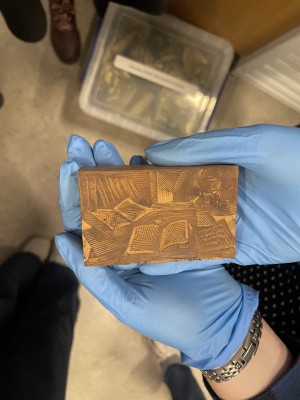Our Digital team focuses on improving both the technical processes and the ways we digitally represent collection items – just as photography has helped us showcase objects, 3D technologies are opening up new possibilities.
Why 3D Matters Now
3D digitisation has become a growing focus in cultural institutions globally, particularly across the EU. The 2019 fire at Notre-Dame Cathedral, which destroyed its wooden spire, highlighted the value of digital preservation.
Our Journey
In 2024, the NLI partnered with a 3D scanning hub to pilot workshops on scanning and printing collection items. Staff explored the tech hands-on and shared feedback throughout the process. We shortlisted and prioritised key items for scanning.
This spring, our scanning partner loaned us a 3D scanner for one week, allowing staff to gain hands-on experience. We’re particularly interested in how 3D scanning can improve access to fragile, detailed, or unusually shaped objects that don’t translate well in 2D.

NLI staff scanning an Elizabeth Rivers woodblock

Benefits of 3D scanning
- Enhanced detail: Items like a bicorn hat - featuring intricate wire ornamentation and inner stitching - are better appreciated in 3D.
- Preservation of fragile items: Objects like the Elizabeth Rivers woodblocks, too fragile for regular handling, are made accessible to everyone through perfect digital replicas.
The road ahead has challenges
- Technical learning curve: Scanning and post-processing require time, training, and precision—steady hands, good timing, and familiarity with tracking software.
- Difficult materials: Reflective, transparent, or hollow items can be challenging for scanners to capture accurately.
This exploration represents our commitment to making Ireland's cultural heritage accessible to everyone, everywhere. Through 3D technology, we're not just preserving history - we're inviting you to experience it in entirely new ways.

Bicorn hat

Scanned details of the bicorn hat


